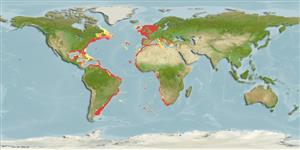Common names from other countries
Environment: milieu / climate zone / depth range / distribution range
Ecologia
marino benthopelagico; oceanodromo; distribuzione batimetrica 2 - 800 m (Ref. 35509), usually 10 - 150 m (Ref. 35388). Subtropical; 60°N - 48°S, 180°W - 180°E (Ref. 114953)
Circumglobal. Eastern Atlantic: Scotland (rare in North Sea) to Morocco, whole of Mediterranean, but not Black Sea; Cap Blanc in Mauritania to Gulf of Guinea, São Tomé Island; Walvis Bay, Namibia to Mossel Bay, South Africa (Ref. 5578). Western Atlantic: Nova Scotia, Canada south to Brazil (Ref. 26340). Eastern Indian Ocean: Australia (Ref. 114953). Southwest Pacific: New Zealand (Ref. 114953).
Size / Peso / Age
Maturity: Lm ? range ? - ? cm
Max length : 180 cm TL maschio/sesso non determinato; (Ref. 2803); common length : 40.0 cm TL maschio/sesso non determinato; (Ref. 3261); peso massimo pubblicato: 90.0 kg (Ref. 7251)
Large ray with a huge, paddle-shaped caudal fin and with no papillae around spiracles. Shiny black or dark grey above, underside white (Ref. 5578). Broad subcircular disc, short snout anterior to the eyes. Smooth skin, short thick tail (Ref. 6902). Dark chocolate to purplish brown above, without spots, white below, but with edges of disc and pelvic fins of same hue as upper surface, tail with irregular dark margins (Ref. 6902).
Juveniles benthic over soft bottoms or near coral reefs (Ref. 12951) from 10-150 m; adults are semi-pelagic to pelagic, swimming in the water column and have been reported to migrate over long distances (Ref. 2803). Found on insular slopes to at least 925 m depth (Ref. 114953). Feeds mainly on pelagic and benthic bony fishes and small sharks (Ref. 5578). Ovoviviparous (Ref. 50449). Produces litters of up to 60 pups. In South Pacific region, males reaches maturity at ca. 60 cm TL (Ref. 114953). Packs a powerful electric shock of up to 220 volts (Ref. 9710).
Life cycle and mating behavior
Maturities | Riproduzione | Spawnings | Egg(s) | Fecundities | Larve
Exhibit ovoviparity (aplacental viviparity), with embryos feeding initially on yolk, then receiving additional nourishment from the mother by indirect absorption of uterine fluid enriched with mucus, fat or protein through specialised structures (Ref. 50449). With up to 60 in a litter. Gestation period one year (Ref. 12951). Size at birth about 23 cm (Ref. 12951).
Stehmann, M. and D.L. Bürkel, 1984. Torpedinidae. p. 159-162. In P.J.P. Whitehead, M.-L. Bauchot, J.-C. Hureau, J. Nielsen and E. Tortonese (eds.) Fishes of the north-eastern Atlantic and Mediterranean. UNESCO, Paris. Vol. 1. (Ref. 2803)
IUCN Red List Status (Ref. 130435)
CITES (Ref. 128078)
Not Evaluated
Human uses
Pesca: di nessun interesse
Strumenti
Special reports
Download XML
Fonti Internet
Estimates based on models
Preferred temperature (Ref.
115969): 7.3 - 27.5, mean 13.9 (based on 3020 cells).
Phylogenetic diversity index (Ref.
82804): PD
50 = 0.5001 [Uniqueness, from 0.5 = low to 2.0 = high].
Bayesian length-weight: a=0.01380 (0.01026 - 0.01858), b=2.99 (2.91 - 3.07), in cm Total Length, based on LWR estimates for this species (Ref.
93245).
Trophic level (Ref.
69278): 4.5 ±0.6 se; based on diet studies.
Resilienza (Ref.
120179): Basso, tempo minimo di raddoppiamento della popolazione 4.5 - 14 anni (Fec=60;).
Fishing Vulnerability (Ref.
59153): Very high vulnerability (90 of 100).
